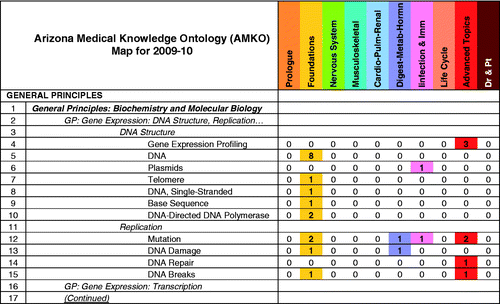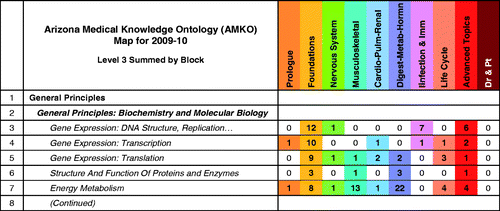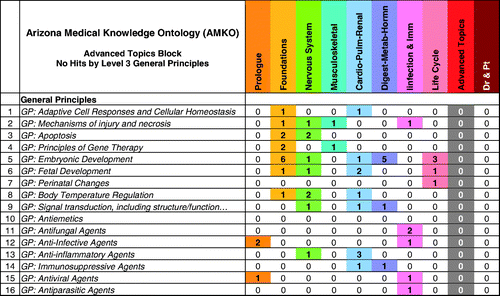Figures & data
Table 1. Illustrative definition of a content map
Figure 1. Illustration of how the USMLE Step I subjects outline was developed into a content ontology. Stage 1 shows deconstruction of the outline's phrases into four increasingly-detailed subject levels. Stage 2 illustrates the population of Level 5 with MeSH terms that are computer-readable and representative of medical knowledge content.

Figure 2. Excerpted from the complete AMKO map, column headings depict the 10 blocks (courses) in chronological sequence for the preclinical curriculum. Rows represent subject heading levels and 11 of 1550 MeSH terms included in the reference ontology (see Level 5 in ). The number in each cell reveals how many instructional sessions in a block (column) feature the specific content signified by that MeSH term (row).

Figure 3. The AMKO map has been collapsed to sum all hits within a set of Level 3 subject headings. This figure is the same format as ; however, rows now include only Level 3 subject headings (see Level 3 in ) and the numbers are the sum of all hits under those headings.

Figure 4. The AMKO map can be filtered to identify the most-to-least frequently mapped content areas. Formatted similarly to , the rows are summed and ranked by frequency of hits across all blocks (last column to the right).

Figure 5. The AMKO map can be filtered by block to reveal unrepresented content. The ‘General Principles’ section of the AMKO map was filtered to show all Level 2 subject headings with zeros for the advanced topics block. The subject areas with zero hits for the advanced topics block can be assessed across the row to ensure coverage in other blocks.

Figure 6. The pattern of content coverage is depicted across all blocks for a broad, comprehensive subject area. Rows represent content headings at Level 2, and the numbers signify the total hits for that level by block. The circle highlights the particular pattern of coverage for the Level 2 heading ‘Immune systems’ across a set of blocks as discussed in the text.
